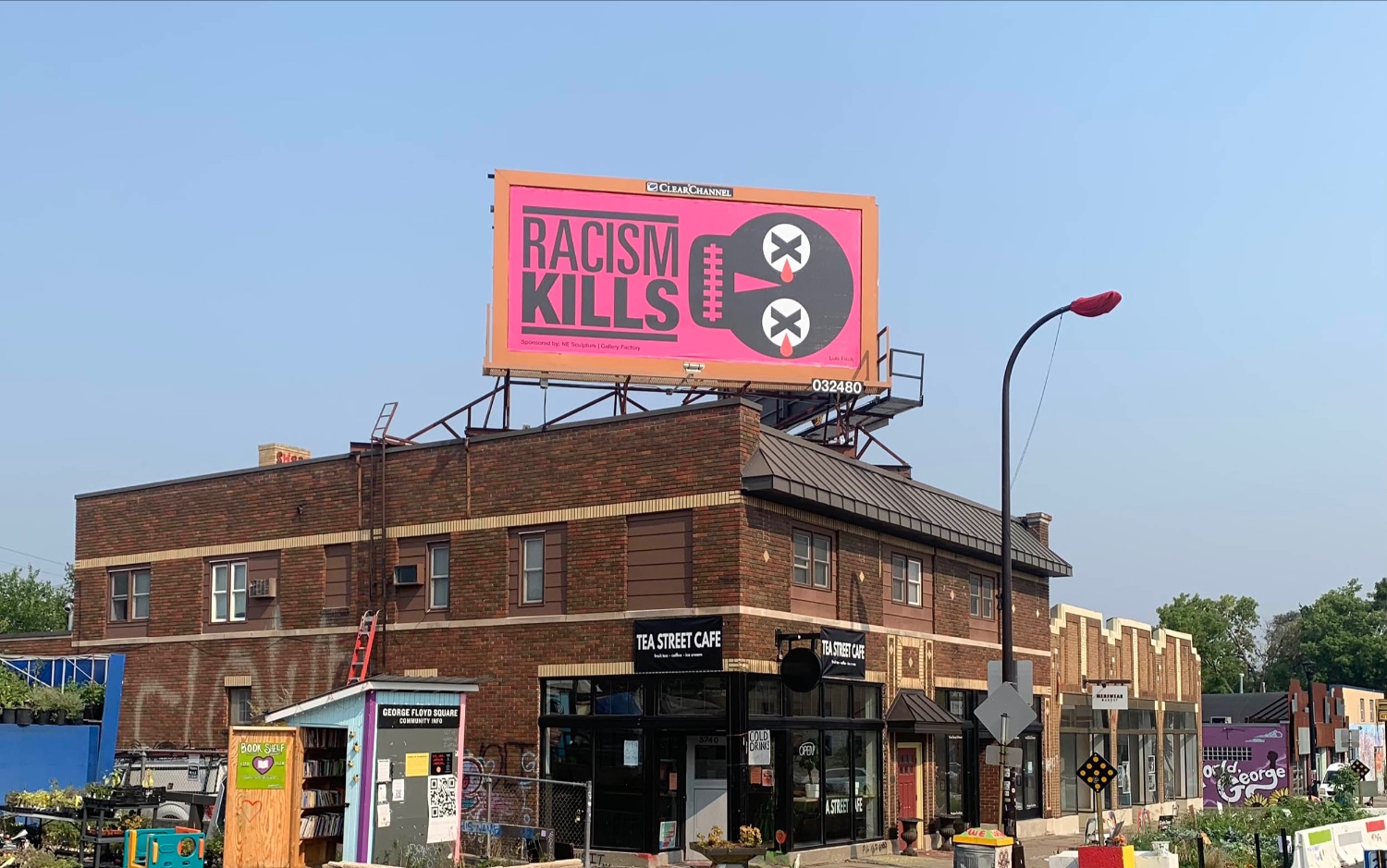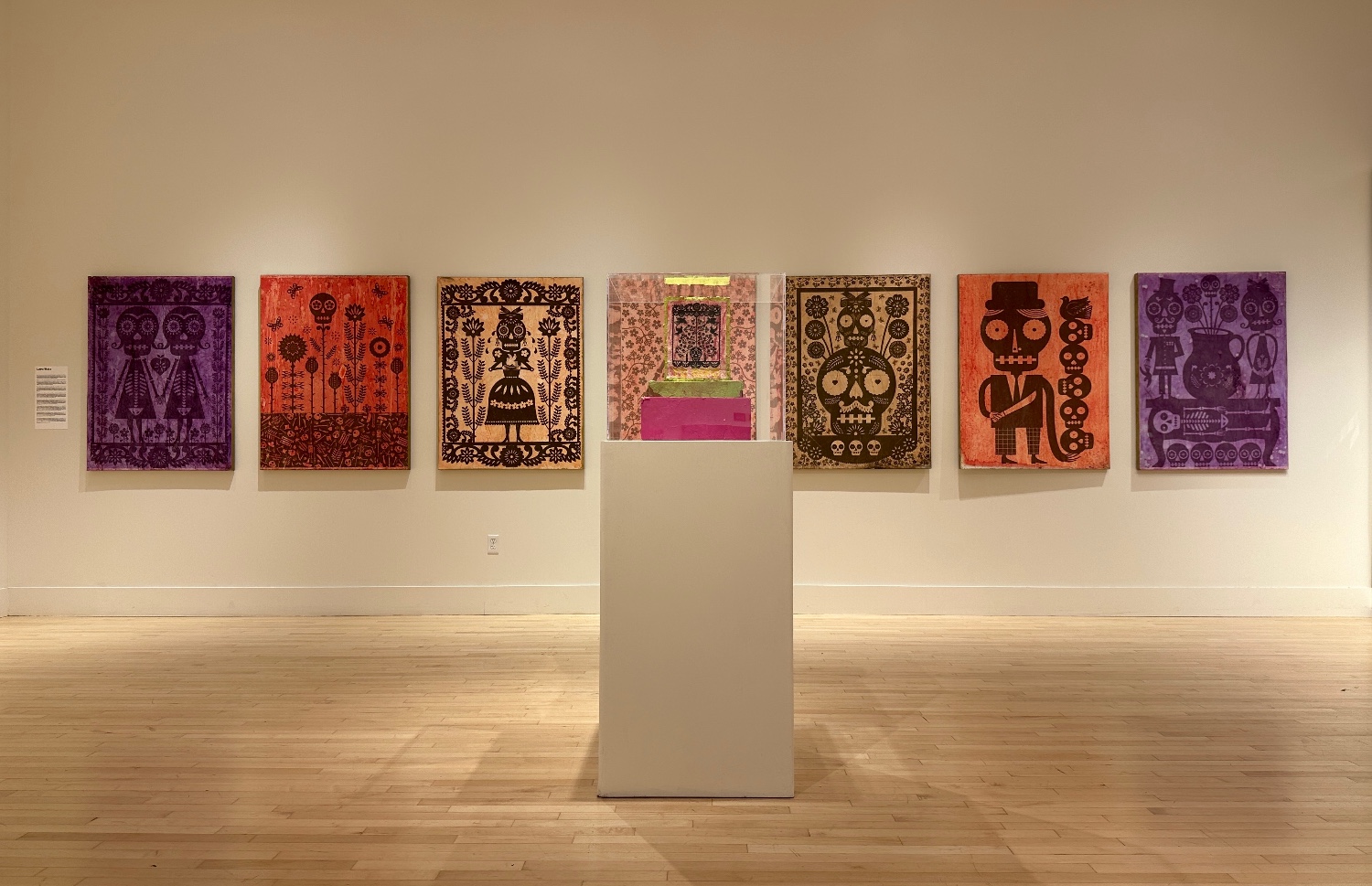
Luis Fitch’s Art Is For the People
Published August 8th, 2024 by Katie Dohman
A career retrospective at the Bloomington Center for the Arts displays his desire for accessibility and dialogue
Acclaimed artist Luis Fitch has had artwork displayed worldwide, from Mexico to Dubai, on the hallowed walls of the Cooper Hewitt, Smithsonian Design Museum, Mia in Minneapolis, and the National Museum of Mexican Art in Chicago.
But 10 years ago, his plan was only to take his art to the people — his people — along Lake Street in Minneapolis, on corrugated cardboard boxes.
Spurred by the 2014 killing of 43 students in Mexico, Fitch — who was born and raised in Tijuana in the 1970s and early 1980s — says he decided to communicate the situation in Mexico, as he saw it, to his own community. “I wasn’t going to wait for art galleries,” he says. “I was going out to the streets and doing my own thing. . . The first time I started interacting with my community at this level was when I was giving art for them.” The free art boxes started garnering praise on social media, igniting a desire to collect them.
He says he kept his focus “always, always on the outdoors,” but it was clear he was making progress toward the institutions that so many revere as a marker of having “made it” — but who, he says, often keep out the communities they should be serving.
“Economically, culturally, morally — everything, the streets — have changed. Art is going to need to change, too. Galleries are disappearing. Artists don’t know where to exhibit,” he says, adding that many legacy institutions aren’t investing in local artists, especially artists of color. “If you are hungry to show your art, you gotta go to the streets.”
 Racism Kills, a public art response to the trauma of the murder of George Floyd. Minneapolis, MN, the site of George Floyd’s murder and memorial. Curated by John Hock. Image courtesy of luisfitch.com.
Racism Kills, a public art response to the trauma of the murder of George Floyd. Minneapolis, MN, the site of George Floyd’s murder and memorial. Curated by John Hock. Image courtesy of luisfitch.com.
There’s been a guiding principal to make that happen as well, he says. “All my practice has been about accessibility in all senses of the word. I want [the audience] to understand the message very fast. I see huge art concepts as BS — I want to communicate in a very straightforward way. And for those collecting my art, I want it to be as inexpensive as possible.” That means he sweats the details, including sizing many of his works to fit in $20 IKEA frames.
That’s also in part due to his own experience growing up. An artist since he was a teen, he recognizes that had he stayed in Tijuana, he may have been one of the “Narco Juniors” who was “disappeared” or left without a viable artistic career path, despite the fact that he learned art and history on the outdoor murals on the walls facing the streets of Tijuana. When he relocated to San Diego, California in 1985, he was just blocks from museums where he could see Picasso and Goya and Warhol — “like a Disneyland to me, it’s in my DNA,” he marvels — and he was able to earn his bachelor’s degree in fine arts from the Art Center College of Design in Pasadena, California in 1990.
But a commitment to his singular voice and vision — the voice of his people, reaching Latinx children and families who may otherwise overlook careers in the arts, bridging cultures between the borderland where he was raised and the country where he has since built his life and career — is likely what landed him many of successes: A prestigious AIGA fellowship, a McKnight Visual Artist fellowship, an appointment from the Minnesota Council on Latino Affairs as Commission Chair of the State Flag and Emblem Redesign, designing four stamps for the United States Postal Service, and to be the first-ever Mexican artist to design Target’s Día de los Muertos collection. Now, a retrospective exhibit — An Anthological Exhibition of Mexican Artist Luis Fitch at Artistry in Bloomington — charts that career across a diverse body of works including prints, paintings, ceramics, and photos.

 An Anthological Exhibition of Mexican Artist Luis Fitch installation details. Photos courtesy of the artist.
An Anthological Exhibition of Mexican Artist Luis Fitch installation details. Photos courtesy of the artist.
Fitch says he tries to limit his mediums and techniques so that he can easily reproduce his work, yet it still spans a variety: Silkscreens, wheatpaste, stencils, vinyl, and mixed-media with graffiti, acrylics, sand, and oil. After the 2020 murder of George Floyd, a billboard went up, a skull tipped on its side on a bold, colorful background with two words: Racism Kills. “You should be able to see it from far away and understand it in two seconds,” he says, and while he was talking about a billboard, he approaches much of his artwork in the same way, even and especially when the topics are as complex and crucially important as racism and climate change.
“Years and years of understanding illustration, art, digital art, and graphic design — I’ve incorporated them into the world of fine art. To me they are all intermixed, it’s just depending on whether you want to turn the volume up or down,” he says. “I’m not so concerned about the technique. I’m more concerned about the message.” And, he says, the work is never meant to push his culture onto another; it’s about bridging them and creating a dialogue between them. It’s building community.
“I don’t think I’m a good artist, or rawer, or better than anybody else. I believe in what I do and I wake up every morning and work on it,” he says. But, he says, he doesn’t do as much talking about art. He makes art. He works to open doors. “I invest, and I work, and I show up,” he says.
 An Anthological Exhibition of Mexican Artist Luis Fitch installation detail. Photo courtesy of the artist.
An Anthological Exhibition of Mexican Artist Luis Fitch installation detail. Photo courtesy of the artist.
The retrospective, he says, is also not about him. It’s again about opening up avenues for Latinx youth to see a career in the arts is both viable and valuable. He knows Latinx parents are encouraging their kids to do something that will get them further along than they are. That includes free entry, free workshops to learn the art of papel picado, and free activity books for families and kids to fill out and navigate the exhibit.
“I know what I am doing is not revolutionary. It’s not Cubism, it is not reinventing anything,” he says, which flies in the face of the creative output, recognizable style, and multitude of topics and mediums he’s embraced. “I am giving hope to my community. That’s all I care about. It’s what I’m always looking for.” ◼︎
 The Art of Luis Fitch, a 432-page volume cataloguing the past decade of the artist's work, available through luisfitch.com.
The Art of Luis Fitch, a 432-page volume cataloguing the past decade of the artist's work, available through luisfitch.com.
An Anthological Exhibition of Mexican Artist Luis Fitch is on view at the Inez Greenberg Gallery at Artistry Theater and Visual Arts in the Bloomington Center for the Arts through September 15.
Gallery hours: Monday – Friday, 8am – 10pm; Saturday, 9am – 10pm; Sunday, 12pm – 6pm.
Workshops: Saturday, August 10, 10 am – 2 pm; Friday, August 30, 1-5 pm
To see more of Luis Fitch's work, visit luisfitch.com or follow him on Instagram @luisfitch.
Banner image: An Anthological Exhibition of Mexican Artist Luis Fitch installation detail. Photo courtesy of the artist.
This activity is made possible by the voters of Minnesota through a grant from the Metropolitan Regional Arts Council, thanks to a legislative appropriation from the arts and cultural heritage fund. 
We can't do it without you.
Help keep independent arts journalism alive in the Twin Cities.